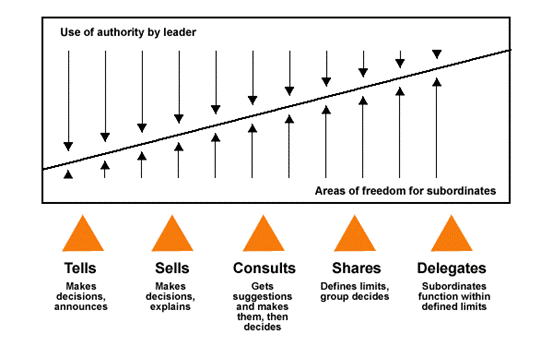Tannenbaum and Schmidt's leadership model
A criticism of early work on leadership styles is that they show leadership in strictly black and white terms. The autocratic and democratic styles or task-oriented and relationship-oriented styles which they described are extremes, whereas in practice the behaviour of most leaders will be somewhere between the two. Contingency theorists, Robert Tannenbaum and Warren Schmidt (1958, 1973), proposed that leadership behaviour varies along a continuum and that as leaders move away from the autocratic extreme the amount of follower participation and involvement in decision taking increases.
They identified three forces that led to the leader's action: the forces in the situation, the forces in the follower and also forces in the leader. This recognizes that the leader's style is highly variable, and even such distant events as a family argument can lead to the displacement activity of a more aggressive stance in an argument than usual.
They proposed a more detailed approach to defining leadership styles. Their model shows the spectrum of possible styles along a continuum linking autocratic leaders, who tell their staff what to do at one extreme, with those who delegate authority for decision-making to subordinates, at the other. The two extremes represent the ideas characterised by Theory X and Theory Y managers. Managers may move along this continuum as external factors alter and situations change. This is shown in figure 1 below.

Figure 1 Tannenbaum and Schmidt's leadership model
It may seem as if the ideal is a position somewhere between the two extremes, but the truth is that the nature of decision-making an effective leader displays can swing constantly between them.